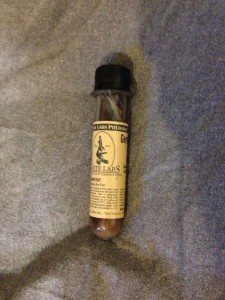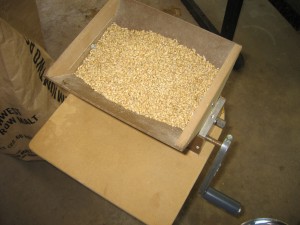Among pale or amber British ales, there is a “ladder” of sorts with regards to strength. Starting at the bottom with ordinary bitters and proceeding through best bitters, ESBs, IPAs, old ales (the amber versions, at least), the list leads all the way up to barleywines. All these beers share similar recipes — the core of which is a pale malt base, with a dose of crystal malt, and ample hopping. Among American ales, a similar ladder exists among the light-colored, hoppy ales — American pale ale gives way to American IPA. And, although there are American barleywines, there’s another beer in the mix — double IPAs (or imperial IPAs). Although both barleywines and imperial IPAs are big, hoppy beers, they do have differences that separate them. These differences can help us to better define barleywine.
Barleywine Defined
Barleywines are strong ales, made mostly from pale malt and usually fitting into the generic “pale ale” recipe type. The alcoholic strength of these beers varies, from some English brews at relatively modest ABVs (such as Old Nick’s, at 7.2%) to some American versions (for example, by Dogfish Head and Founders) up to 15% ABV. (The BJCP gives 8–12% ABV as the range.) Some barleywines are darker in color, but if the beer has a significant amount of roast flavor, it’s generally not called a barleywine. One thing that sets barleywine apart from other big, pale or amber beers — including double IPA, and even Belgian tripels — is the relatively high final gravity (FG) and resulting sweetness and body that comes with it. It is not uncommon for barleywines to finish in the “20s” — FG 1.020–1.029.
Barleywines are generally well-hopped. At a minimum. they have as many IBUs as pale ale (at least 30), but more frequently their bitterness rating is on par with IPAs or double IPAs. (The BJCP gives 35–70 IBUs as the range for English barleywine and 50–120 IBUs as the range for American barleywine.) Of course, the body and sweetness of the beer decreases the perception of bitterness somewhat so that some barleywines with high IBUs taste more balanced than bitter.
Barleywines are strong and hoppy, but they are also malty, full-bodied and often sweet. Good double IPAs are a showcase for hops — the malt character, body and yeast character are lowered to the point they do not interfere with the expression of the hops. Good barleywines are beers that balance a strong hop bitterness, flavor and aroma with a malty character, full body and often an estery aroma from the yeast. Good double IPAs retain a fair amount of “drinkability,” even at their high alcoholic strength, while the best barleywines are beverages to be sipped and savored.
Barleywine covers a lot of ground. In this series, I’ll focus mostly on brewing “classic”-type barley wines — such as those similar to Thomas Hardy Ale and J.W. Lee’s Vintage Harvest ale on the English side and Anchor’s Old Foghorn and Sierra Nevada’s Bigfoot on the American side. However, keep in mind that there are a lot of interesting variants in this style.
Brewing Barleywine at Home
Brewing a barleywine can be a challenge. Compared to normal-strength beers, brewing a barleywine might push the limits of your system on brewday and present problems during fermentation. In this series, I will explain the options for both extract and barleywine wort production, and how your method of wort production should influence your recipe choices. I will use my recent articles on big wort production, big extract wort production and parti-gyle (and parti-gyle-like) brewing techniques as background. However, I will additionally describe hopping strategies to deliver the hop character you need in a barleywine without having all the plant material soak up wort and excessively rob you of yield.

You’ll need a lot of yeast. A yeast starter is required for this style of beer, unless you’re only brewing approx. 1 gallon (4 L)
I will also stress that running your fermentation well is the biggest key to making a quality barleywine. Among the biggest factors that contribute to a healthy fermentation is the number of yeast cells pitched, and I will cover a couple option for ensuring a proper pitch. The amount of care required to shepherd a fermentation successfully to completion goes up with higher original gravities and I’ll discuss techniques you may need to employ if your beer is stronger than 10%, or 12%.
Finally, I will give a couple barleywine recipes — one English and one American. However, I hope that after reading this series you will have the ability formulate your own barleywine recipe based on the capacity of your mash/lauter tun and kettle, your ability (or willingness) to raise yeast, your planned method of wort production and your goals for the strength of the beer.
Now is a great time of year to brew barleywine and have it ready late winter (with some leftover to age for next winter).
The next artice in this series discusses extract wort production.



Speak Your Mind